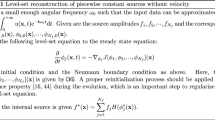Abstract
This work introduces a new algorithm for surface reconstruction in ℝ3 from spatially arranged one-dimensional cross sections embedded in ℝ3. This is generally the case with acoustic signals that pierce an object non-destructively. Continuous deformations (homotopies) that smoothly reconstruct information between any pair of successive cross sections are derived. The zero level set of the resulting homotopy field generates the desired surface. Four types of homotopies are suggested that are well suited to generate a smooth surface. We also provide derivation of necessary higher order homotopies that can generate a C 2 surface. An algorithm to generate surface from acoustic sonar signals is presented with results. Reconstruction accuracies of the homotopies are compared by means of simulations performed on basic geometric primitives.
Similar content being viewed by others
References
Keppel, E.: Approximating complex surfaces by triangulation of contour lines. IBM J. Res. Dev. 19(1), 2–11 (1975)
Fuchs, H., Kedem, Z.M., Uselton, S.P.: Optimal surface reconstruction from planar contours. Commun. ACM 20(10), 693–702 (1977)
Boissonnat, J.D.: Shape reconstruction from planar cross sections. Comput. Vis. Graph. Image Process. 44(1), 1–29 (1988)
Bajaj, C.L., Coyle, E.J., Lin, K.N.: Arbitrary topology shape reconstruction from planar cross sections. Graph. Models Image Process. 58(6), 524–543 (1996)
Boissonnat, J.D., Memari, P.: Shape reconstruction from unorganized cross sections. In: Proceedings of the Fifth Eurographics Symposium on Geometry Processing, p. 98. Eurographics Association (2007)
Liu, L., Bajaj, C., Deasy, J.O., Low, D.A., Ju, T.: Surface reconstruction from non-parallel curve networks. In: Computer Graphics Forum, vol. 27, p. 155. (2008)
Hoppe, H., DeRose, T., Duchamp, T., McDonald, J., Stuetzle, W.: Surface reconstruction from unorganized points. Comput. Graph. 26(2), 71–78 (1992)
Carr, J.C., Beatson, R.K., Cherrie, J.B., Mitchell, T.J., Fright, W.R., McCallum, B.C., Evans, T.R.: Reconstruction and representation of 3D objects with radial basis functions. In: Proceedings of the 28th Annual Conference on Computer Graphics and Interactive Techniques, pages, p. 76. ACM, New York (2001)
Amenta, N., Bern, M.: Surface reconstruction by Voronoi filtering. Discrete Comput. Geom. 22(4), 481–504 (1999)
Zhang, Y., Rohling, R., Pai, D.K.: Direct surface extraction from 3D Freehand ultrasound images. In: IEEE Visualization, pp. 45–52. (2002)
Allgower, E.L., Georg, K.: Numerical continuation methods: an introduction. Springer, New York (1990)
Shinagawa, Y., Kunii, T.L.: The homotopy model: a generalized model for smooth surface generation from cross-sectional data. Vis. Comput. 7(2), 72–86 (1991)
Berzin, D., Hagiwara, I.: Minimal area for surface reconstruction from cross sections. Vis. Comput. 18(7), 437–444 (2002)
Fujimura, K., Kuo, E.: Shape reconstruction from contours using isotopic deformation. Graph. Models Image Process. 61(3), 127–147 (1999)
Armstrong, M.A.: Basic Topology. Springer, Berlin (1983)
Ona, E., Andersen, L.N., Knudsen, H.P., Berg, S.: Calibrating multibeam, wideband sonar with reference targets. In: OCEANS 2007-Europe, pp. 1–5 (2007)
Hyman, J.M.: Accurate monotonicity preserving cubic interpolation. SIAM J. Sci. Stat. Comput. 4(4), 645–654 (1983)
Wolberg, G., Alfy, I.: Monotonic cubic spline interpolation. In: Proceedings of Computer Graphics International, 1999, pp. 188–195. (1999)
Späth, H.: Exponential spline interpolation. Computing 4(3), 225–233 (1969)
Pruess, S.: An algorithm for computing smoothing splines in tension. Computing 19(4), 365–373 (1978)
Beros, I., Marusic, M.: Evaluation of tension splines. Math Commun 4, 73–81 (1999)
de Boor, C., Swartz, B.: Piecewise monotone interpolation. J. Approx. Theory 21(4), 411–416 (1977)
Costantini, P., Morandi, R.: Monotone and convex cubic spline interpolation. Calcolo 21(3), 281–294 (1984)
Simmonds, E.J., MacLennan, D.N.: Fisheries Acoustics: Theory and Practice. Blackwell, Oxford (2005)
Perona, P., Malik, J.: Scale-space and edge detection using anisotropic diffusion. IEEE Trans. Pattern Anal. Mach. Intell. 12(7), 629–639 (1990)
Soille, P.: Morphological Image Analysis: Principles and Applications. Springer, New York (2003)
Gonzalez, R.C., Woods, R.E.: Digital Image Processing, 2 edn. Prentice Hall, New York (2002)
Aspert, N., Santa-Cruz, D., Ebrahimi, T.: Mesh: Measuring errors between surfaces using the Hausdorff distance. In: Proceedings of the IEEE International Conference on Multimedia and Expo, vol. 1, pp. 705–708. (2002)
Coppersmith, D., Winograd, S.: Matrix multiplication via arithmetic progressions. J. Symb. Comput. 9(3), 251–280 (1990)
Author information
Authors and Affiliations
Corresponding author
Rights and permissions
About this article
Cite this article
Sharma, O., Anton, F. Homotopy-based surface reconstruction with application to acoustic signals. Vis Comput 27, 373–386 (2011). https://doi.org/10.1007/s00371-011-0544-4
Published:
Issue Date:
DOI: https://doi.org/10.1007/s00371-011-0544-4



